The September and October, we’re taking a look at the jam-packed 1994 to 1995 season of Star Trek, including Star Trek: Deep Space Nine and Star Trek: Voyager. Check back daily for the latest review.
Equilibrium is another troubled Dax episode. Dax is probably the hardest character on the Star Trek: Deep Space Nine cast to write for, if only because of the character’s central premise. “Well-adjusted functionally immortal alien slug inside a young woman’s body” is a nice character description, but it’s hard to ground a character-driven story in that. It’s tempting just to turn the Dax symbiote into a convenient macguffin that can drive various plots.
To date, Playing God is really the only Dax-centred episode of Deep Space Nine that has placed the emphasis on Jadzia rather than the slug inside here. (Although Blood Oath did at least try to deal with how a current Trill host deals with obligations incurred by past lives.) In Dax, the symbiote was a gateway to a pretty conventional and generic murder mystery story. In Invasive Procedures, the symbiote was something particularly valuable to be stolen and exploited.
The biggest problem with Equilibrium is that – like Dax and Invasive Procedures before it – the episode uses the Dax symbiote as a springboard to a story that is more driven by Sisko and Bashir than it is by Jadzia Dax. While Equilibrium does have a great hook and some biting social commentary, Dax feels more like a plot point than a character in her own right.
As with The Search, Part I and House of Quark, there’s a sense that Deep Space Nine is trying to get some mileage out of its new recruits. Three of the first four episodes of the season were written by writers joining the show from the writing staff of Star Trek: The Next Generation. To be fair, this was necessitated by the fact that Robert Hewitt Wolfe was on his honeymoon at the time, but there’s also an eagerness to put these experienced writers to work.
In this case, the Star Trek veteran is René Echevarria. Echevarria had only joined the writing staff of The Next Generation in its sixth season, although he had worked on the show since its third year. Echevarria contributed the script for The Offspring, which was heavily re-written by Michael Piller and Melinda Snodgrass. However, his work had so impressed Piller that Echevarria was tasked with writing the penultimate script of the third season, Transfigurations.
The writer had worked on the show in that support capacity for quite some time before being drafted in to write on the series full-time. In the commentary for I, Borg, Echevarria credits that decision to the emergence of Deep Space Nine. With the writing staff split like that, new blood was necessary. So Echevarria joined the staff full-time, working on the final two years of The Next Generation.
When the time came to split the Next Generation writing staff between Deep Space Nine and Voyager, Echevarria moved with Ronald D. Moore to Deep Space Nine. Equilibrium is his first script for the show, and it’s almost perfectly suited to the writer. Equilibrium is essentially an episode about trying to take a big science-fiction concept and make it personal. This is a story about a woman with a slug in her belly who discovers that she is not who she thinks she is.
Echevarria’s approach to Star Trek was decidedly more personal than many of his contemporaries, specialising in character studies or more intimate plots, something the writer himself acknowledges:
“I was always attracted to the human side of the story and less to the spaceships or aliens or whatever,” said Echevarria, 49, whose jet black hair and surname hint at his Cuban roots. “Brannon had the really mind-trippy ideas, and I’d be like, ‘What if (the android character) Data had a baby?’ I used to get lots of letters saying, ‘Star Trek needs more female writers like you.'”
Gender stereotyping aside, Echevarria is something of an unsung hero of Star Trek. While Ronald D. Moore gets a lot of credit for his character-focused storytelling, Echevarria has a unique ability to take something impossibly foreign and alien, only to make it seem organic and personal.
Equilibrium doesn’t quite work like that. The story opens with a nice focus on Dax. The idea of the character having visions and hallucinations, haunted by memories that can’t possibly have occurred, makes for a compelling story hook. Deep Space Nine has been running for over two seasons at this point, and Dax is the character on the show with the firmest sense of identity. She’s clearly at peace with herself. Upsetting that – by suggesting that she doesn’t know herself as well as she might think – is an excellent story premise.
However, once the show reaches the half-ways point, Dax loses focus. She’s pushed to the background as Sisko and Bashir work frantically to save her. The episode’s climax features Sisko asserting Dax’s agency to the Trill government. “The point is it’s not up to me or you to decide,” he contends, correctly. “It’s her life and her decision.” The problem is that the scene is constructed as three characters (two male leads and female guest star) arguing over an unconscious character.
In Captains’ Logs Supplemental – The Unauthorized Guide to the New Trek Voyages, Ronald D. Moore accepts these criticisms, suggesting that it was a result of the writing process on the episode:
The more the script was rewritten over and over again, it just kept losing focus and regaining focus. It’s just one of those things where you’re trying real hard to make it work, but ultimately you’re not satisfied with the end result. It’s an intriguing idea, and the episode holds up pretty well in some of its elements, but it’s not quite satisfying in the last couple of acts. It becomes too much of Bashir and Sisko running around investigating the mystery rather than concentrating on the character of Dax.
This feels a little bit too much like Invasive Procedures, another story with a strong hook for Dax that essentially amounts to an account of how Sisko and Bashir save the day.
And Equilibrium does do some nice work with Sisko and Bashir. For one thing, Sisko is firmly established as less of a moral pillar than Picard ever was. When Sisko uncovers the lies spread by the Symbiosis Commission, he leverages that secret to keep Jadzia safe. Essentially, Sisko is willing to allow the Symbiosis Commission to continue its charade, so long as his best friend is allowed to live. Considering the disdain with which Picard was willing to condemn corrupt regimes in episodes like The Hunted, it feels like a conscious effort to distinguish Sisko from Picard.
It’s a decidedly more morally ambivalent leader than most Star Trek fans are used to. After all, Sisko’s decision to play along with the Symbiosis Commission essentially amounts to allowing the population of Trill to live in sheltered ignorance. In a way, it demonstrates that the compromise of In the Pale Moonlight was not a moment of moral weakness from an otherwise upstanding character. Sisko has consistently been demonstrated to be willing to compromise on practical grounds.
And Equilibrium also allows room for development of Bashir. With the arrival of the staff from The Next Generation on Deep Space Nine, Bashir’s character begins to gel in a way that he never did before. The third season doesn’t feature any stand-out Bashir episodes, but it does build up the character to the point that the fourth season contains Hippocratic Oath, The Quickening and Our Man Bashir. The fact that Bashir’s first-season character episode was The Passenger should illustrate how far he’s come.
The third season sees a shift in the portrayal of Bashir as a character that really allows for those later stories, building a character who is much more sympathetic than he was during the first two seasons, while retaining the same blend of innocence and arrogance that defined the station’s medical officer. Here, for example, we get a less cringe-inducing pick-up-type back story for Bashir’s interest in medicine, and one that fits a lot more comfortably with with what we learn of his family life than the version he offers in Melora.

Well, let’s face it, that’s about the least embarrassing thing she could have caught Bashir reading…
In Melora, he claimed that he had a traumatic experience as a child with his father than inspired him to become a healer. Here, he offers a much less cliché sentiment, grounding his interest in medicine in the character’s arrogance. Reflecting on his own childhood fear of doctors, he offers, “They seemed to know everything. It was as if they held the power of life and death in their hands. I used to think that if I didn’t behave, they’d make sure I got sick. Then as I got older, I decided that I wanted to know what they knew, be as smart as they were.”
Although it is worth noting that the story takes a little of the edge off Bashir’s ego by allowing him to concede that he isn’t just in it for the opportunity to be better or smarter than common people. When Dax asks whether this inspired him to go to medical school, Bashir confirms it. “And you know what I learned there? That all I really wanted to do was help people. That’s what doctors are there for, to help.” So Equilibrium manages to keep Bashir’s aloof arrogance while still humanising him slightly.
It’s also nice to confirm that Bashir and Dax really are platonic friends at this point in the series. His over-eager pursuit of Dax in the show’s early seasons bordered on creepy – with the show only getting away with it by focusing on how amused Dax was by Bashir’s attentions. It’s nice to see that relationship evolve into genuine friendship. Here, the two can visit each other in the middle of the night and fall asleep in each other’s quarters as nothing more than close friends.
To be fair, there are other problems with the structuring of the script. As has been noted before, it’s very hard to structure a mystery on Star Trek, because the show simply isn’t grounded in the real world. Viewers and writer’s can’t take for granted basic rules of physics, biology or technology that often ground such stories. Here, Sisko and Bashir are probing into an alien culture and seeking to uncover its mysteries, but Equilibrium has to be structured in such a way as to provide the viewer with enough information to keep up with the plot.
So we get lots of exposition awkwardly structured into conversations and dialogue, as the episode tries to craft a framework into which it can graft the subsequent revelations. For example, Bashir namedrops Torias and provides details of his death long before any suspicion is raised around that transition in the symbiote’s life. It feels a little awkward that this is the one thing that stands out in the entire medical history of the Dax symbiote, and just happens to be relevant to the mystery that the characters don’t even know about yet.
“Well, according to your file, the only major trauma the Dax symbiont ever suffered was when Torias Dax was injured in a shuttle accident,” Bashir explains. “He was Dax’s fifth host, wasn’t he?” Sisko exposits. “Yes, right before Curzon,” Dax confirms. This provides a nice segue into what will become the key to the whole mystery. “It says here that Torias remained in a comatose state for just under six months.” It’s not the most elegant piece of structuring in the history of the franchise, even if it is basically functional.
Similarly, the revelation that most of the population is compatible for joining won’t carry any punch if the show doesn’t emphasise the myth perpetuated by the Symbiosis Commission that very few Trill are compatible with symbiotes. So the nice little character scene between Dax and Bashir on the Defiant has to contort to acknowledge this fact as dramatic set-up. When Dax complains about her time as an Initiate, Bashir bluntly responds, “Considering the risk of rejection, you can’t really blame them. If they were to put a symbiont to an unsuitable host, they’d both be dead in a matter of days.”
Still, Equilibrium continues the development of Trill culture that began with Invasive Procedures – the second season episode that first hinted at the existence of a class structure among Trill society. A lot of the stronger ideas in Equilibrium are developed directly from Invasive Procedures. The division of Trill culture into “joined” and “unjoined” is the most obvious example, but there’s also the ruthless pragmatism of the system.
In Invasive Procedures, the Dax symbiote seemed perfectly willing to let Jadzia die once it bonded with Verad. Here, that sense of ruthlessness is shown to exist across the whole of Trill society. Reflecting on dangers to the symbiote, Dax confesses, “Sometimes the host is sacrificed to save the symbiote.” While the symbiote is precious and irreplaceable, the host is treated as an expendable shell. Trill society was willing to lie about the circumstances of Tobin’s death to preserve its big secret, while Renhol is perfectly willing to let Jadzia die to prevent the secret of Joran getting out to the general public.
Here, we discover that an entire underclass of unjoined Trill exist to cater to the every need of the symbiotes. It’s almost presented as a religious obligation. “They get very cranky if everything’s not perfect,” one such carer muses. “You don’t want them cranky.” The symbiotes seem to expect this standard of treatment. “They can be very demanding.” Timor is so devoted to the symbiotes that he hasn’t been outside in years. “I miss sunshine,” he admits.
Of course, this whole society is revealed to be a lie – much like Quark’s scathing indictment of Klingon culture in House of Quark. When Renhol is confronted with the truth of the myth that the Symbiosis Commission has fed to the public, it’s interesting that she sums up the situation in capitalist and democratic terms:
Do you realise what would happen if you did that? It would mean chaos. There aren’t enough symbionts for that many hosts. The potential danger to the symbionts would be enormous. They would become commodities to be purchased or prizes to be fought over. Nearly half our population is capable of being Joined. That’s what we learned from our unfortunate experience with Joran Dax. Now do you understand why you must not reveal the truth?
The symbiotes would be reduced to base commodities in an unchecked capitalist system. The carefully structured reality of Trill society would break down. Everything would go to pieces.
It’s worth reflecting again that the Trill exist as a class-based society in Gene Roddenberry’s explicitly classless future. While it’s never explicitly confirmed that Trill is a Federation member, it is presented as a close ally. The philosophies at play here stand at odds with the values and virtues that the Federation takes for granted. This mirrors the mid-nineties discourse that was opening up on the myth of America as a classless society. As great an idea as that was, it simply wasn’t true in the nineties; if it ever had been.
Like House of Quark, there’s a sense that Equilibrium exists as part of America’s mid-nineties social introspection. In the wake of the Cold War, the country had the freedom to focus on itself. Having vanquished the last great enemy of the twentieth century, people began to wonder why things weren’t as perfect as they should have been; why the government wasn’t able to provide properly for its citizens; why the structures of government seemed more caught up in cynical politicking than solving genuine problems.
Like Quark in the last episode, Dax is made a scapegoat for a corrupt and indifferent government. The Trill are willing to sacrifice Jadzia Dax in order to preserve the status quo. There’s a righteous anger at the heart of Equilibrium, a sense that Deep Space Nine is genuinely frustrated that such a cold and uncaring system could actually exist. This is – in a way – the most angry that Deep Space Nine would ever get about anything. Indeed, it was a far cry from the balanced reflection of The Next Generation.
You could read Equilibrium as social commentary in the grand tradition of Star Trek. It feels like a pointed cliché of unchecked capitalism. In a future without currency, scarcity and competition still exist. Social class is a reality that must be acknowledged. Trill rise through the social classes through acquisition of a symbiote. Based on Verad’s sad story in Invasive Procedures, they are indoctrinated into this way of thinking at a young age.
The Trill dream mirrors the American dream. The ideas is that, if you are smart enough and willing to work hard, anybody can get ahead. Of course, that’s not entirely true. There is, after all, only so much to go around. Opportunity is never quite as simple as those stories might make it seem. People can work hard for all their lives and still not get a piece of the pie. There are societal and institutional hurdles that exist to prevent the radical redistribution of that sort of wealth.
This is the reality of American society. However, the myth of opportunity has its uses, even if it isn’t necessarily borne out in fact. D.V. Glass noted as much in Social Mobility in the 1954. Writing in the aftermath of the Second World War in Britain, Glass observed that the myth of opportunity for advancement was as important to the functioning of society as the reality of that opportunity.
“Indeed, even if there is little actual opportunity to rise in social status, the belief in a myth of opportunity may produce similar results,” he mused. He pointed out that there are various reasons why society might want to limit radical shifts in social class while still maintaining that such shifts were possible:
For those who fall in social status, the sensation of being déclassés is scarcely a comfortable one. Concern to ensure a rise, or at least to prevent a fall, in status is part of the ‘anxiety neurosis’ so evident in ‘middle-class’ parents’ aspirations for their children and in the willingness of the parents to make very substantial sacrifices so long as those children can obtain the kind of education which connotes relatively high future status. In addition, actual movement itself may, save in special circumstances, distort or destroy kinship associations, with with possible personal and social deprivation. We need to encourage mobility for the advantages it offers to individuals and to society; but we also need to avoid, as far as possible, such disadvantages as may follow from having a social structure in which the status relationships between individuals in successive generations will be far less stable than at present of during the last half-century.
It seems like this observation may have played a part in the exploration of Trill society in Equilibrium, a society powered by the myth of opportunity for personal advancement, but where the reality is obscured somewhat.
The parallels to American culture are obvious. As Richard Weiss points out in The American Myth of Success, the mere myth opportunity for advancement is strong enough to allow the maintenance of the status quo:
The relation of the success myth to American capitalism has been an ambivalent one. On the one hand, as many historians have noted, the “rags-to-riches” tradition, by creating an illusion of opportunity, served as a social pacifier inimical to reform.
The system ensures its own survival by cynically exploiting optimism and idealism to make sure that cynicism wins out. It’s a rather bleak observation, and Equilibrium is a rather bleak little episode.
Unlike episodes of The Next Generation like The Hunted, Equilibrium ends with our heroes participating in the cover-up. Sisko doesn’t reveal the truth to the people of Trill. He doesn’t bend Starfleet’s policy of non-interference in order to ensure a just result. The best he can manage is the return of Jadzia in return for his silence. As such, Sisko becomes complicit in the continuation of the corruption and the lies that underpin Trill culture.
Things don’t change. The world isn’t suddenly made better. The reality remains. This pretty heavy and cynical stuff. It’s little wonder that Deep Space Nine couldn’t hang on to all the Star Trek fans flicking over after The Next Generation came to an end. There’s a very solid argument to be made that all this peaceful corruption and polite complicity is even more cynical than the compromises that would be made during the show’s sixth and seventh seasons. At least those compromises were made to ensure the survival of entire civilisations. Here, compromises are made simply because they are easier.
While it’s not the strongest Jadzia-centric episode the show would ever produce, Equilibrium is still a provocative piece of work. The title refers as much to cynical political realities as it does to mind of the lead character.
You might be interested in our reviews of the third season of Star Trek: Deep Space Nine:
- The Search, Part I
- The Search, Part II
- House of Quark
- Equilibrium
- Second Skin
- Supplemental: Fearful Symmetry by Olivia Woods
Filed under: Deep Space Nine | Tagged: 1994, 1995, america, Anger, bitterness, class, Dax, deep space nine, ds9, ennui, equilibrium, reflection, René Echevarria, ron moore, social commentary, Trill |















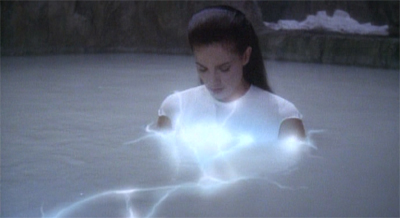


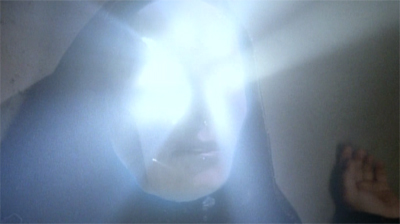





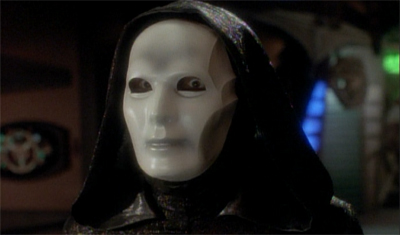


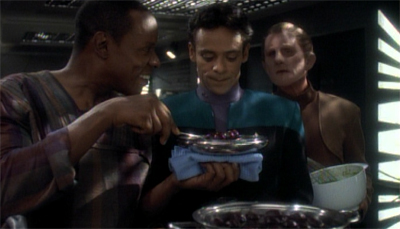



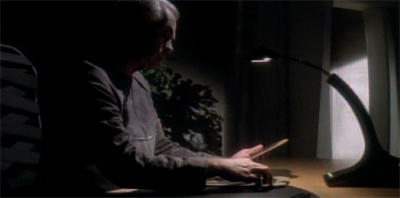







Darren, when I used to collect The Star Trek Fact Files I do believe it said that the Trill were Federation members. That makes Sisko threatening to blow the whistle on the Symbiosis Commission more a case of a pet being forced to submit to its master. That’s a little chilling.
I used to collect those too, although I think my binders have fallen apart. They were great little things, weren’t they?
I still have all of mine. I would never part with them, because they’re a wealth of information on the Star Trek universe.
They are incredibly well researched.
I sold my entire Fact&Files collection recently. It is just too much for a small flat.
Regarding the “solution” of this episode: You seem to dismiss in the end that completely opening up the symbiosis-procedure would lead to even more corruption. We never get to know on what basis the decisions are being made. Sure, transparency and some democratic process might prove superior on a moral ground, but wouldn’t that mean that still mayne people are excluded by chance? Isn’t the much bigger question if the joined Trill themselves are somewhat privileged (if you count a worm taking over half (?) your mind a privilege…).